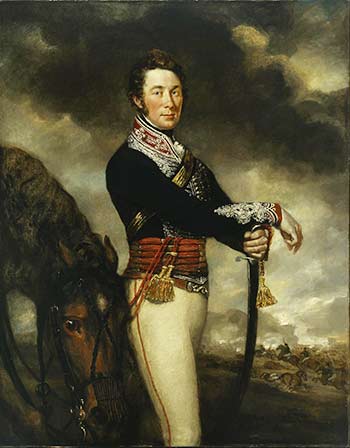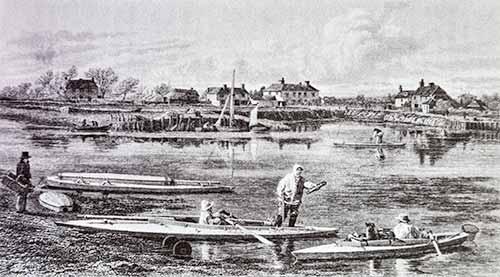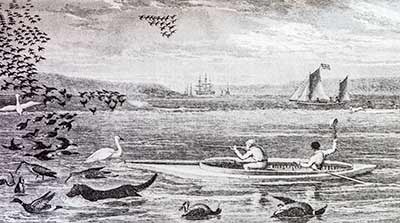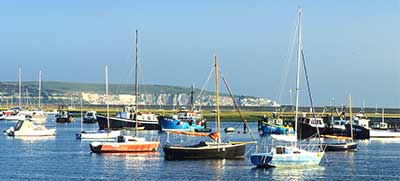Colonel Peter Hawker
Colonel Peter Hawker, a 19th century military man, diarist, author, 'sportsman', firearms inventor, amateur musician and artist, was, unfortunately for the local birdlife, closely connected with the Keyhaven and Pennington marshes, for he spent much of his time slaughtering anything and everything that could fly.
Reflecting prevailing attitudes at the time, his 'sporting' prowess was much celebrated as were his boasts and vivid descriptions of killing wild birds in frighteningly large numbers during expeditions here and elsewhere.
(1) The early years and military service

Born in 1786, Hawker enjoyed a privileged London upbringing and an Eton education. Again reflecting how times change, in 1801 at the ridiculously early age of 15 years, he was able to purchase a commission as a cornet - the lowest grade of commissioned officer - in the Royal Dragoons (1st Dragoons).
He was quickly 'promoted' to Captain but noted: 'I was a Captain of Dragoons soon after I was 17 years old, but paid dearer for it than anyone in the service'. This was clearly an important occasion for him as we find a diary note on August 4th, 1840: 'Keyhaven. Anniversary of my purchasing a troop in the 14th Light Dragoons in 1804 when only 17 years, 7 months and 11 days old'.
(The rank of cornet and the ability to purchase commissions were both abolished in the Army Reform Act, 1871).
During active service in the Peninsula War (1807-1814), he received a serious thigh wound and was declared unfit for service, awarded an annual pension and 'sold' his commission. Yet despite ill health, he was able in 1815 to accept another commission, this as major in the North Hampshire Militia of which he was subsequently made lieutenant-colonel before going on to become deputy lieutenant for the county.
(2) From London and Longparish to Keyhaven

Hawker spent a considerable amount of time at his London residence and at Longparish House in the Test valley, whilst a cottage in Keyhaven served as a base for his wildfowling exploits.
(Longparish House dates back to the 17th century and is now Grade II* listed. It was on the market in 2008 with an asking price of £9m. Hawker's punt gun, a large wildfowling weapon that peppered the air with shot rather than firing a single shot, was included in the sale).
He first visited Keyhaven on August 26th, 1814, having left his carriage at Lymington and walked the rest of the way. So impressed was he by it as 'a wild-fowl place' that he immediately 'made some provisional arrangements for a future winter'.
After another visit, however, on January 28th, 1815, he described it as being 'amongst unfrequented marshes and bogs' where he feared 'the danger of being bogged or drowned'. But never-the-less, on April 6th in the same year he noted: 'Having purchased Mr Lee's cottage at Keyhaven, I this day went to Lymington to arrange for the rebuilding of the house'.
And so began Hawker's association with these wild marshes.
(3) Author and wildfowler

Hawker is perhaps best know for his exploits as a wildfowler and general killer of wild birds, pastimes that were sadly even more acceptable in his day than today; and as the author of a wildfowling book, 'Instructions to Young Sportsmen', which was first published in 1814.
His shooting and other adventures were extensively recorded in diary form, starting in 1802 and continuing until just before his death in 1853. Extracts from the diaries were first published in 1893 as 'Hawker's Diaries', with further editions continuing until at least the late 1980s. The 1988 abridged version runs to over 750 pages in two volumes and in addition to wildfowling notes includes many insights into the ways of life of local inhabitants, weather patterns, wildlife and happenings in the wider world.
Just one of many unsavoury accounts from the local marshes dates back to January, 1823: 'My swan that I shot yesterday having died and been picked up, there remained 7 of these magnificent birds, and they were seen off Keyhaven sitting among what little ice was left .... and every corner of the creeks or on shore contained a gunner anxiously hoping that they might possibly swim or fly near enough for a random shot. .... I let drive at their necks and knocked down and brought home 2 wild swans or hoopers. I had to finish one of them with an old musket, or he might probably have escaped; and I wounded a third severely. .... Got also this day 10 geese and 5 wigeon.'
And just as awful, albeit on a smaller scale, on December 14th, 1829 he notes: ' .... all I fired at was (one barrel) at 4 curlews, all of which came into the larder. This shot, although at mere rubbish, was a satisfactory beginning'.
Although much went unrecorded, 17,753 kills are noted in the diaries including 1,327 brent geese, 7,035 partridges, 135 teal, 118 curlews, 1,329 dunlins, 28 dotterels, 5 stone curlews, 58 quails, 631 hares, 18 herons and 12 whimbrels.
Regular encounters on the marshes with other shooters, including what were described variously as 'swarms of gunners' and 'gangs of shore shooters', illustrate just how much pressure the wildlife faced. Indeed, it's a wonder anything at all survived. He also records, though, details of local people following behind the gunners in the hope of retrieving dead or dying birds, presumably for the pot - times then were certainly tough for the poorer members of society.
Hawker also made his mark on the landscape, too, for on December 8th, 1838 he noted that a visit to Keyhaven was made to 'place all the booms in another new leak that I had cut .... through 'Stivers' mud for nearly half a mile, in order to get to 'Pennington Leak' without going round by Hurst'. Maybe this was what is now known as Hawker's Lake, a lengthy channel through the mudflats a little to the south-east of Keyhaven village, which is still shown on modern Ordnance Survey maps.
Hawker's Cottage in Keyhaven still stands, a suitably imposing property near to The Gun Inn.
References:
The Diary of Colonel Peter Hawker, 1802-1853: Colonel Peter Hawker
Quick links
More links
Search this site

